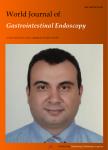A typical presentation of a rare cause of obscure gastrointestinal bleeding
A typical presentation of a rare cause of obscure gastrointestinal bleeding作者机构:Department of Internal Medicine D University Hospital Münster Albert-Schweitzer Str. 33 Münster 48149 Germany Department of Internal Medicine B University Hospital Münster Albert-Schweitzer Str. 33 Münster 48149 Germany Department of General and Visceral Surgery University Hospital Münster Albert-Schweitzer Str. 33 Münster 48149 Germany Gerhard Domagk Institute of Pathology University Hospital Münster Albert-Schweitzer Str. 33 Münster 48149 Germany Department of Radiology University Hospital Münster Albert-Schweitzer Str. 33 Münster 48149 Germany
出 版 物:《World Journal of Gastrointestinal Endoscopy》 (世界胃肠内镜杂志(英文版)(电子版))
年 卷 期:2011年第3卷第2期
页 面:40-45页
学科分类:1002[医学-临床医学] 100214[医学-肿瘤学] 10[医学]
主 题:Gastrointestinal stromal tumor Gastrointestinal neoplasms Gastrointestinal hemorrhage Computed tomography
摘 要:A 52-year-old white woman had suffered from intermittent gastrointestinal (GI) bleeding for one year. Upper GI endoscopy, colonoscopy and peroral doubleballoon enteroscopy (DBE) did not detect any bleeding sour ce, suggesting obscure GI bleeding. However, in video capsule endoscopy a jejunal ulceration without blee ding signs was suspected and this was endoscopically conf irmed by another peroral DBE. After transfusion of packed red blood cells, the patient was discharged from our hospital in good general *** weeks later she was readmitted because of another episode of acute bleeding. Multi-detector row computed tomography with 3D reconstruction was performed revealing a jejunal tumor causing lower gastrointestinal bleeding. The patient underwent exploratory laparotomy with partial jejunal resection and end-to-end jejunostomy for reconstruction. Histological examination of the specimen confirmed the diagnosis of a low risk gastrointestinal stromal tumor (GIST). Nine days after surgery the patient was discharged in good health. No signs of gastrointestinal rebleeding occurred in a followup of eight months. We herein describe the comp lex presentation and course of this patient with GIST and also review the current approach to treatm ent.



